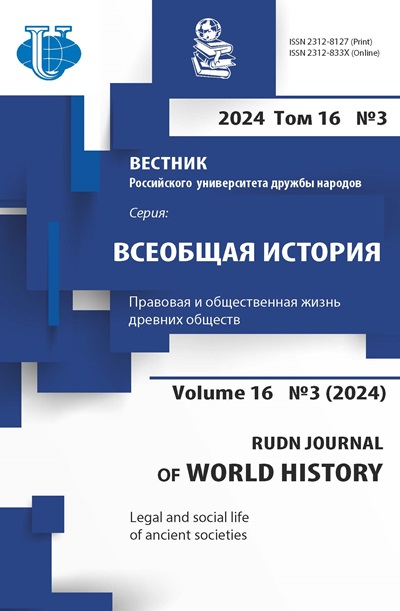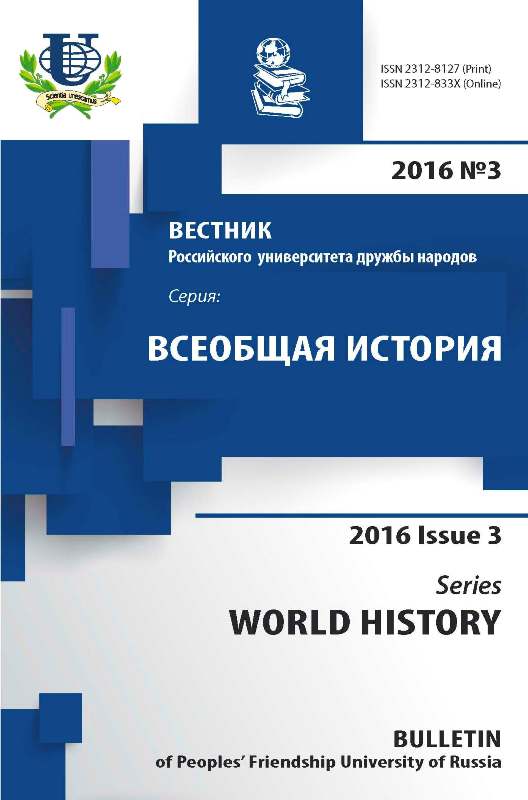No 3 (2016)
- Year: 2016
- Articles: 11
- URL: https://journals.rudn.ru/world-history/issue/view/875
Articles
REGIME OF "GUIDED DEMOCRACY". ON THE ISSUE OF THE FORMATION OF THE IDEOLOGY OF THE "THIRD POSITION" IN INDONESIA
Abstract
The author reveals the basic provisions of the ideology of the "Third Position" in the Indonesian political leadership model. By the end of the 50's Sukarno completed the formation of the doctrine of the "Third Position ". Analyzing the current political model, Sukarno appealed to the identity, rejecting capitalism that generates colonialism and fascism. He rejected, first of all, the very psychological foundation of liberal capitalism - individualism, the guiding to the competition and struggle, and therefore unacceptable to Indonesia concept of "Third Position". Sukarno meant building a socio-economic model of traditional, patriarchal and egalitarian society based on the principle of community solidarity and mutual assistance. The main element of the social model, according to Sukarno thought, was the family as the center of solidarity, led by the patriarch, the head of the family. The principle of family has been moved Sukarno all Indonesian society. Sukarno himself became father of the nation, to decide for all, in the name of all. The thesis of this period "The main thing in our democracy is a governance ''
RUDN Journal of World History. 2016;(3):7-18
 7-18
7-18


PRACTICES OF ISLAMIC STATE (ISIS) IN THE CONTEXT OF ISLAMIC ESCHATOLOGY
Abstract
The History has shown once again, that one cannot fight something that one does not understand. In modern warfare both the military and the ideological fronts are at the same level of intensity, as the victory always depends not only on battlefield triumphs, but also on enlisting new adherents and holding to the old ones. And after two years of fight of the “Obama Alliance” against IS in Syria and Iraq there is a clear indication, that Caliph Ibrahim (Abu Bakr al-Baghdadi) is winning on both fronts. The main goal of this article is an attempt to explain reasons underlying the success of ISIS leadership, that allowed the Islamists not only to evade the “degrade and destroy” strategy of the coalition, but also to build a new state, in the light of the context of Islamic eschatological concepts. To reach this goal, we strive to not only understand the perspectives of this newly-founded state and possible forecasts for its sustainability, but also to look into the reasons of IS attractiveness for large groups of people from a variety of countries and regions, through the lens of Islamic eschatology.
RUDN Journal of World History. 2016;(3):19-31
 19-31
19-31


ECCI AND USSR OFFICIAL RADIO BROADCASTING TO FRANCO’S SPAIN DURING EARLY PART OF WORLD WAR II
Abstract
The author of the article looks into the problem of the contribution made by the Executive Committee of the Communist International to Radio Moscow official broadcasting to Francoist Spain in September 1939 - June 1941. Firstly, he analyzes how Radio Moscow organized broadcasting to Spain in this period, what sort of people worked in the Spanish language editorial office of Radio Moscow and what informational materials they needed to perform. Secondly, the author examines how the ECCI organized radio propaganda within its apparatus. Basing on the analyses’ results, the author makes it clear that the Executive Committee of the Communist International provided Radio Moscow with native Spanish-speaking staff, as well as with the corresponding informational materials, radio news, articles etc.
RUDN Journal of World History. 2016;(3):32-39
 32-39
32-39


SOME ASPECTS OF FORMING THE POPULATION OF EAST AND CENTRAL ASIA IN ANCIENT TIMES
Abstract
Using anthropological materials as historical sources to show the main problems of the ethnogenesis of the peoples of East and Central Asia makes it possible to understand the important and complex issues as the role of Mongolian, Chinese, Turkic, Tungusic, Tibeto-Burman, Iranian and other peoples in the formation of the ethnic composition of the population of these regions. The article traces the migration routes of various racial components, the nature of their mixing, crushing and interference in antiquity.
RUDN Journal of World History. 2016;(3):40-51
 40-51
40-51


ON ISSUE TO THE COMPOSITION OF THE EARLIEST OIRATS
Abstract
The article investigates the important historical problem that scientists are engaged in almost two centuries - the origin and composition of the Oirats. Recent discovered sources suggest the presence in the mid. XV - the mid. XVIII centuries of three Oirat groups, successively replaced one another. The author, basing on known and newly discovered sources, recent researches, studies the composition of the earliest Oirats and underlines their Turkic and Mongolian origin as essential for understanding of the subsequent history of this nation. In our opinion, the earliest Oirats had been a confederation of four groups of Mongol and Turkic tribes, approximately comparable to the four main nomadic groups pointed out by Rashid-al-Din. The unique political position and influence of Oirats during the Mongol period has allowed them to maintain their identity until XVIII century.
RUDN Journal of World History. 2016;(3):52-57
 52-57
52-57


THE POSITIONS OF THE ARAB STATES OF THE PERSIAN GULF ABOUT THE SETTLEMENT OF SYRIAN CRISIS
Abstract
The problem of Syrian conflict’s escalation has assumed a new character during this year: threat of terrorism to the whole world community rose, more political actors became a party to the conflict, the unquenchable wave of migration became the reason of social, demographic and economic issues on the European continent. The Persian Gulf’s states are more sensible to the continuation of civil war in Syria by its geopolitical factors. The cause of this is their national and regional security’s interests. On the basis of the importance of the regional states’ role in Syrian crisis, this article contains the comprehensive analysis of the position of the Persian Gulf’s Arab states in the discussing and settlement of the conflict in Syria.
RUDN Journal of World History. 2016;(3):58-62
 58-62
58-62


THE HISTORY OF DEVELOPMENT OF THE “SOFT POWER” POLICY IN CHINA
Abstract
The article is devoted to the People’s Republic of China “soft power” policy. The author holds a historical analysis of appearance of China's foreign policy vector, which is based on tradition and "Eastern" specificity. Nowadays China’s role at the region and international level is very significant, it is linked to the country opinion in the settlement of international conflicts, decision of the global problems, participation in various scale’s events. Over the 66 years of the People's Republic of China’s existence the country has shown itself in many areas: economic, political, humanitarian, social, financial and others. The author emphasizes that nowadays the Chinese image policy is one of the most urgent and popular. The Government of China created a platforms for the implementation of the “soft power” policy to abroad - it's Confucius Institutes, Chinese cultural centers and others. The governance of China actively leads the "soft power" in the implementation of domestic and foreign policy of the state.
RUDN Journal of World History. 2016;(3):63-72
 63-72
63-72


ABOUT EVERYDAY LIFE OF WORKING WOMEN IN CHINA DURING THE GREAT LEAP FORWARD (SECOND HALF OF 50'S - EARLY 60-IES OF THE XX CENTURY)
Abstract
The article is devoted to the daily life of Chinese women in the first decade after the founding of the People's Republic in 1949, when, as the center line of the further development of Chinese society embarked on the construction of socialism. Particular attention in the framework of political and economic programs of the CCP has been given to "women's issues": acquiring an equal social status with men, women were regarded as a powerful base for the realization of the objectives and the government as a solid support to their husbands for the common good. However, the happiness and comfort of each woman were also under the strict control of the party.
RUDN Journal of World History. 2016;(3):73-81
 73-81
73-81


INSCRIPTIONS ON STELAE OF THE GENERAL KASA. TRANSLATIONS AND HISTORICAL COMMENTARY
Abstract
The present article contains a reproduction and a full translation of hieroglyphic inscriptions on 4 stelae from the lost tomb of general Kasa at Saqqara (XIX Dyn.). The publication of inscriptions on the stelae includes a short description of images and sacred symbols carved on them. The spells inscribed on these stelae are mainly the extracts from Chapter 151 of the Book of the Dead. The unique peculiarity of stelae is the shallow niches carved in the form of objects intended for the magical protection of the dead in his tomb: a mummyform figurine, a torch, a statuette of a jackal Anubis and a djed-pillar. The author touches also a question of the stelae original location inside the tomb itself. As the present location of Kasa’ tomb is unknown the layout of stelae in the tomb’s decoration program remains hypothetical. The comparison with private funeral complexes of the New Kingdom in Thebes and Memphis let us to state that the stelae of Kasa are an ensemble which has not known parallels.
RUDN Journal of World History. 2016;(3):82-95
 82-95
82-95


REVIEW OF A BOOK "XINJIANG: CHINA'S MUSLIM BORDERLAND". N-Y., 2014. 469 P.
RUDN Journal of World History. 2016;(3):96-99
 96-99
96-99


OUR AUTHORS
RUDN Journal of World History. 2016;(3):100-101
 100-101
100-101
















